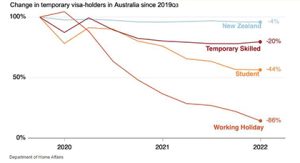Migration and business stalled by COVID – report
The COVID pandemic brought migration to Australia to an effective standstill and was the cause of half a million temporary migrants deserting the country and creating a worker shortage, according to new research.
A report from the Grattan Institute shows there were about 1.5 million temporary migrants in Australia as of January 2022, compared with almost two million in 2019.
 The 500,000 ‘missing migrants’ are mainly international students and working holiday makers, the report, titled ‘Migrants in the Australian workforce’, says.
The 500,000 ‘missing migrants’ are mainly international students and working holiday makers, the report, titled ‘Migrants in the Australian workforce’, says.
It says there are roughly 335,000 international students in Australia now – about half as many as in 2019 – and only 19,000 working holiday makers – about 85 per cent fewer.
The number of temporary skilled workers is also down by about 20 per cent but almost all of the 660,000 New Zealand citizens living in Australia on temporary visas remained throughout the pandemic.
The report says the shortfall of migrant workers from the uncapped temporary migration program is hurting some businesses more than others.
“Before the pandemic about 17 per cent of workers employed in hospitality were here on temporary visas. These temporary migrants were overwhelmingly international students earning some money as waiters, kitchen hands and bar attendants,” the report says.
“Demand for these services remains high, so its little wonder employers in the hospitality industry are screaming out for staff.
“The most recent data from the Australian Bureau of Statistics shows about 33 per cent of hospitality businesses in February were advertising for staff, compared with 15 per cent in February 2020,” the report says.
Meanwhile farmers are struggling because working holiday makers, who have made up about 4 per cent of the agricultural workforce, are almost entirely absent.
Some commentators have attributed Australia’s historically low unemployment to the border closures.
Closed borders may well have boosted the employment prospects and wages of locals in sectors where temporary migrants – especially students and working holiday makers – have made up a large share of the workforce. That’s likely to have benefited younger Australians, especially those working in hospitality.
But the fact there are fewer migrants in Australia now than before the pandemic is unlikely to have had much impact on the employment prospects and wages of Australian workers overall, the report’s authors argue.
When migrants come to Australia, they spend money – on groceries, housing, transport, hospitality and so on. Fewer migrants means less of that spending, which means less demand for labour to make those goods and provide those services, the authors say.
Another Grattan Institute research paper showed government spending and the Reserve Bank’s stimulus policies, not border closures, are the main reason for the low unemployment rate.
And it shows the effect record low interest rates and unprecedented levels of government support for businesses and households is seven to eight times larger than the effect of the border closure.
See the full report here: Migrants in the Australian workforce – Grattan Institute












